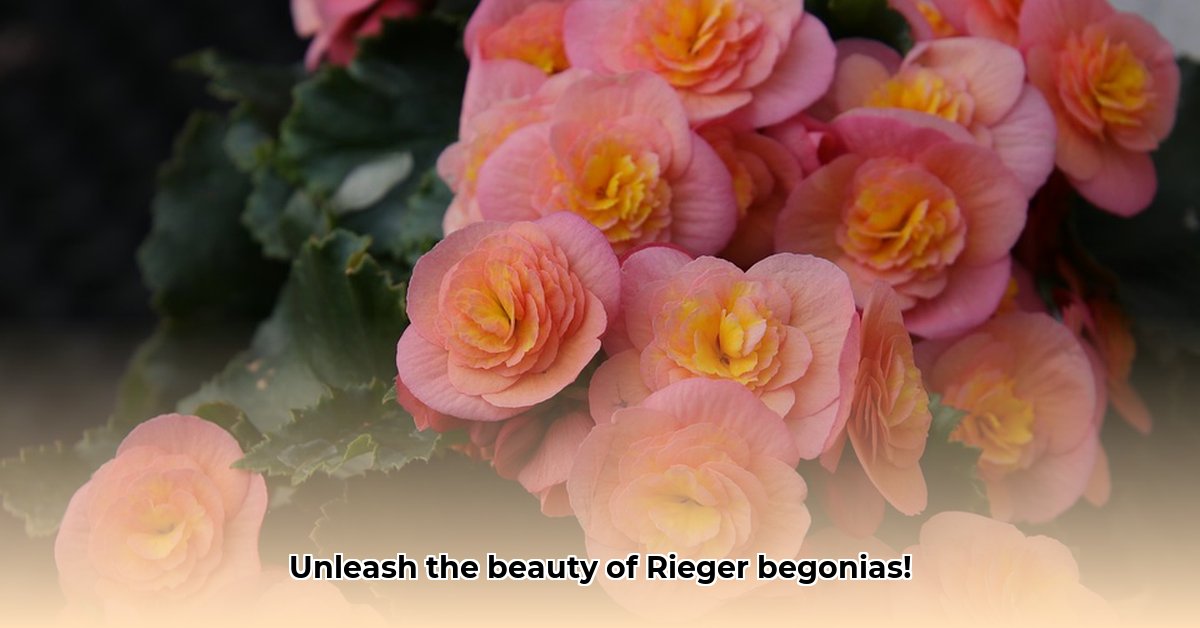Want to grow gorgeous Rieger begonias? Fantastic! These vibrant flowers are a visual treat, but knowing a few key things can make all the difference. This guide walks you through what you need to know, from getting them started to keeping them happy and healthy. We’ll cover the basics like light, watering, and propagation, share tips and tricks to avoid common problems, and even discuss fertilizer. For more stunning flower options, check out these red flowers. Whether you’re a seasoned gardener or a complete beginner, we’ve got you covered. Let’s get those begonias blooming!
Understanding Rieger Begonias: A Guide to Stunning Blooms
Rieger begonias are loved for their vibrant blooms and relatively easy care, making them perfect for both experienced gardeners and beginners. Let’s dive into nurturing these beauties, focusing on how to grow Rieger begonias successfully.
Light and Temperature: Finding the Perfect Spot
These plants thrive in bright, indirect light. Think of a spot in your home that gets plenty of gentle sunlight, perhaps an east-facing window. Avoid direct sunlight, which can scorch their leaves. Imagine the light filtering through a sheer curtain – that’s ideal. Aim for a consistent temperature between 60 and 75°F (16-24°C). Avoid chilly drafts to keep your begonias happy. The right environment is critical for your plant’s well-being!
Watering Wisdom: The Goldilocks Approach
Overwatering is a common mistake with Rieger begonias, so let’s get this right. Use a well-draining potting mix that allows water to flow freely. Before watering, check the soil’s moisture level. Stick your finger about an inch into the soil; if it feels dry, it’s time to water thoroughly. Allow excess water to drain completely. The key is to keep the soil moist, but never soggy. Think of a “damp sponge” consistency – not dripping wet. A good rule of thumb is to water when the top inch of soil feels dry to the touch.
Propagation: Growing Your Own Begonia Family
Want to expand your begonia collection? Propagating from stem cuttings is surprisingly easy. Here’s how:
- Select a Cutting: Choose a healthy stem, about 3-4 inches long, with several leaves.
- Prepare the Cutting: Remove the lower leaves from the cutting, leaving just a few at the top to focus the plant’s energy on root production.
- Root the Cutting: You have two options:
- Water Propagation: Place the cutting in a glass of water, ensuring the bottom node (where leaves were removed) is submerged. Change the water every few days.
- Soil Propagation: Dip the cut end in rooting hormone (optional, but it encourages root growth) and plant it directly in moist potting mix.
- Maintain Humidity: Keep the cutting warm and humid. You can cover it with a plastic bag or humidity dome to create a mini-greenhouse effect. Ensure adequate ventilation to prevent mold growth.
- Patience is Key: It typically takes several weeks for roots to develop. For water propagation, you’ll see roots forming in the water. For soil propagation, gently tug on the cutting after a few weeks; resistance indicates root growth. Once roots have developed, plant your new begonia in its own pot.
Feeding for Fabulous Blooms: Nutrients and Fertilizers
Regular feeding helps your begonias produce abundant blooms. During the active growing season (spring and summer), use a balanced liquid fertilizer diluted to half-strength every two to four weeks. Look for a fertilizer formulated for flowering plants, with a higher phosphorus content (the middle number in the N-P-K ratio). Follow the instructions on the fertilizer packaging carefully – it’s easy to overdo it! Over-fertilizing can harm your plants. Flush the soil occasionally with plain water to prevent salt buildup from fertilizer.
Pest Patrol: Protecting Your Plants
Rieger begonias can be targeted by pests like aphids, mealybugs, and spider mites. Regularly inspect your plants, including the undersides of leaves. Signs of infestation include sticky residue, webbing, or visible insects. For small infestations, you can often remove pests manually with a cotton swab dipped in rubbing alcohol or a strong jet of water. For larger infestations, insecticidal soap or neem oil are effective options. Be sure to follow the product instructions carefully, and test on a small area of the plant first to ensure it doesn’t cause damage. Good air circulation also helps prevent pest problems.
Troubleshooting: Addressing Challenges and Diseases
Here’s a breakdown of common problems and their solutions:
| Problem | Possible Causes | Solutions |
|---|---|---|
| Leggy Growth | Insufficient light, lack of pruning | Increase light exposure. Prune back leggy stems to encourage bushier growth. |
| Yellowing Leaves | Overwatering, underwatering, nutrient deficiencies, root rot | Adjust watering based on soil moisture. Check for nutrient deficiencies by fertilizing with a balanced fertilizer. Inspect roots for signs of rot (soft, brown, or mushy). Remove any affected roots and repot in fresh, well-draining soil. |
| Drooping Leaves | Overwatering, underwatering, lack of humidity | Adjust watering. Increase humidity by grouping plants, placing them on a pebble tray filled with water, or using a humidifier. |
| Few Flowers | Insufficient light, improper fertilization | Increase light exposure. Fertilize with a high-phosphorus fertilizer during the growing season. |
| Powdery Mildew (white, powdery coating on leaves) | Poor air circulation, high humidity | Improve air circulation by spacing plants further apart and using a fan. Remove affected leaves. Apply a fungicide specifically formulated for powdery mildew. |
| Bud Drop | Temperature fluctuations, dry air, insufficient light | Maintain consistent temperatures. Increase humidity. Ensure adequate light exposure. |
Keeping Your Begonias Blooming Year After Year: Long-Term Care
With consistent care, your Rieger begonias can thrive for years. Regularly remove spent flowers (deadheading) to encourage new blooms and maintain a neat appearance. During the winter months, your begonias might enter a period of dormancy; reduce watering and withhold fertilizer during this time. Don’t be alarmed if they seem less active – this is a natural process. In early spring, resume regular watering and fertilizing to encourage new growth and blooms. Repot your begonia every one to two years, or when it becomes root-bound, using fresh potting mix.
Growing Rieger Begonias from Stem Cuttings: A Detailed Guide
Key Takeaways:
- Start with healthy cuttings, provide ideal conditions, and practice proper care.
- Both water and soil propagation can be successful, depending on your preferences.
- Optimal humidity is crucial for root development.
- Avoid overwatering to prevent rotting.
- Experiment to master the process.
Choosing Cuttings: The Foundation for New Plants
Selecting the perfect cuttings is key. Choose healthy, non-flowering stems, about 3-5 inches long. Look for firm, vibrant stems free from diseases or pests. Use a sharp, clean剪刀or pruning shears to make the cut, just below a node (the point where leaves emerge). This encourages root growth.
Propagation Methods: Water vs. Soil
Two main methods exist for propagating Rieger begonias: water and soil.
- Water Propagation: Place the cutting in a glass or jar of water, ensuring the bottom node is submerged but the leaves remain above the water line. Change the water every few days to prevent bacterial growth. Place the jar in a bright, indirect light location. Roots should begin to form within a few weeks.
- Soil Propagation: Dip the cut end in rooting hormone (optional) and plant it directly in a small pot filled with well-draining potting mix. Water gently to moisten the soil.
Here’s a comparison:
| Method | Pros | Cons |
|---|---|---|
| Water | Easy to monitor root development | Can be slower; roots may be more fragile |
| Soil | Faster establishment; less transplant shock | Difficult to monitor root development; risk of rot |
Creating the Perfect Environment: Humidity and Light
Regardless of the method, humidity and light are important. For both methods, maintain high humidity around the cuttings, especially during the initial rooting phase. You can do this by covering the cutting with a plastic bag or humidity dome, or by placing it in a greenhouse. Ensure adequate ventilation to prevent mold growth. Place the cutting in bright, indirect light. Avoid direct sunlight, which can scorch the leaves.
Caring for New Plants: Ensuring Healthy Development
Once the roots have developed (this can take several weeks), it’s time to transplant your new plants into individual pots filled with a suitable growing medium. A well-draining potting mix is essential. Water regularly, allowing the soil to dry slightly between waterings. Fertilize every few weeks with a diluted balanced fertilizer. Gradually acclimate the young plants to their new surroundings.
Troubleshooting Common Issues
Overwatering is a common cause of failure. Allow the soil
- Modern Backsplash Ideas: A Guide to Todays Kitchen Trends - December 18, 2025
- Ceramic Kitchen Wall Tiles: Style and Protection for Your Walls - December 17, 2025
- Kitchen tiling wall: Elevate your kitchen with stylish wall tiles - December 16, 2025









